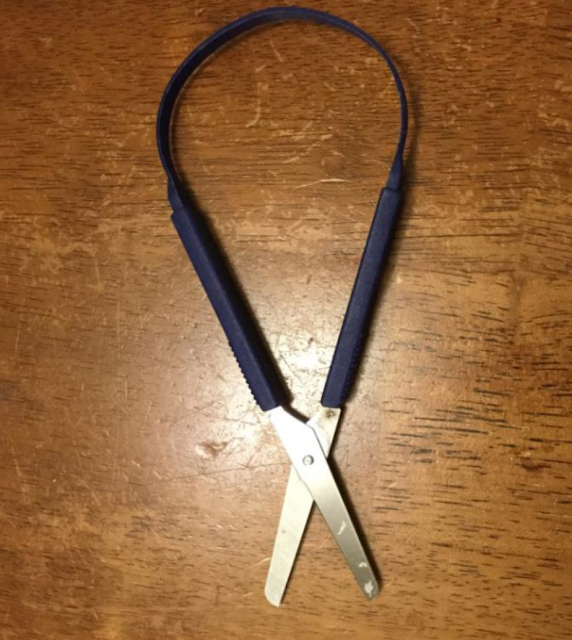AT Case Study: Three Adaptive Scissors for Jacob
By: Sue Stubbs, EC-SEAT Scholar
Jacob is a preschool-aged child who has severe physical abilities and benefits from modifications within a school setting. During this case study, many different tools were used to help assist in fine motor skills such as cutting. The cutting tools were used to determine which one worked best to fit the specific needs of this child.
Jacob is a preschool-aged child who has severe physical abilities and benefits from modifications within a school setting. During this case study, many different tools were used to help assist in fine motor skills such as cutting. The cutting tools were used to determine which one worked best to fit the specific needs of this child.
“Jacob” is a five-year-old boy who attends an inclusionary preschool program.
He has very limited use of his hands and his inability to complete fine motor tasks because of low muscle tone. Jacob’s Impairment affects his ability to grasp writing tools and small objects to complete fine motor tasks. Jacob will be able to use fine motor tools to help succeed in the preschool setting academically. The adaptive scissor device that is selected will help improve Jacob’s ability to perform fine motor tasks such as cutting in the preschool setting.
Task of Difficulty
The task that Jacob needs assistance with is using fine motor tools in the preschool setting. He needs assistance to complete academic tasks such as writing and cutting in the preschool setting. The specific functional limitation that Jacob has is that he is unable to use his hands effectively to perform fine motor skills such as painting, writing, and cutting.
Goal: Jacob will be able to use specialized scissors to perform fine motor tasks in the preschool environment.
Three different Adaptive Scissors that were tried with “Jacob”
- Adapted Battery Operated Scissors can be found on Amazon and can be expensive. These can begin at $86.29
- PETA Easi-Grip Scissors/Push Down Table Scissors can be found on Amazon for 13.99 or in Therapy stores for $24.95. These scissors help those cut with limited use of hands and fingers.
- Mini Loop Scissors can be found on Amazon and can begin at a price of $6.99.
Pros and Cons of the Assistive Technology Tools
Adapted Battery Operated Scissors
- Pros: These scissors have a switch attached that allows for easy use for someone with a physical impairment in the hands and fingers. This device would be helpful for Jacob to use when completing cutting tasks. He would be able to hit the switch to begin the cutting process.
- Cons: Expensive; uses 4 AA batteries, the switch is not included. Due to the expense of this device and the use of batteries, this device was not purchased for Jacob. Since other devices seemed more appropriate at the time the Team decided to use a different device for cutting purposes.
PETA Easi-Grip Scissors/Push Down Table Scissors
- Pros: These scissors are easily adaptable for those with a physical impairment in the hands and fingers. They are small and easy to take place to place. They are perfect for those with low muscle tone and limited control in hands and fingers. These scissors were found to be the most useful and user-friendly for Jacob. He is able to participate in cutting activities with his classmates with the use of these scissors.
- Cons: These scissors may slip on the table when cutting and not easy to use when cutting items that need to be turned. For Jacob, these scissors were slipping on the table, however, with the use of small no-slip padding, he is able to use these scissors effectively. Another idea that will be tried with Jacob in the future is using a corrugated board that will hold the scissors in place while cutting.
Mini Loop Scissors Mini Loop Scissors
- Pros: These scissors are modified for those with limited fine motor control.
- Cons: These are not great scissors for those who have difficulty holding scissors. Jacob struggles to hold these scissors and he became easily frustrated.
The Chosen AT Tool
The device that Jacob will use is the PETA Easi-Grip Scissors/Push Down Table Scissors. These scissors are fitted with two T shaped handles. These scissors can be used by depressing the handle with the scissor in a stable position or by “scooting” the scissors across the table. These scissors have a spring that automatically reopens when pressure is released.Reflection
During this Case Study it was a great opportunity to explore various low-cost Assistive Technology tools that help assist fine motor and cutting skills. By exploring various tools educators were able to determine what works best for “Jacob”.





Comments
Post a Comment
We invite you to share your thoughts and additional resources with our community of readers.
Also, contact us if you would like to be a guest blogger.